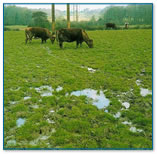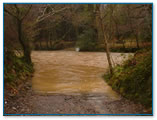agriculture,
rivers and land management
 |
Irrigation of
crops |
Farmers manage agricultural land
so that crops can be grown and livestock raised successfully. Equally,
if wildlife is to flourish it needs a helping hand and good land
management practices on a farm can help wildlife and rivers.
Farming can put great demands
on the environment, the need for water for livestock to drink and
water to wash equipment and water crops are just three examples.
|
|
|
Strawberries under plastic
|
|
|
 |
Livestock poaching |
Farming can also leave land susceptible
to erosion (soil loss) after a crop has been harvested (because
the ground is bare and unprotected) or soil is worn away through
livestock movement.
When cattle churn up the soil
with their hooves it is called ‘poaching’ and can lead
to soil being washed into a stream or river by the rain. More soil
or sediment on a streambed is not good news for salmon and trout
as it will clog up the gravel and affect the survival of their eggs
(B9d).
There are many ways that farmers
use to manage their land to benefit wildlife and fisheries, see
the next section on Rivers & Land Management Methods (L06)
 |
Poaching by stream |
 |
Sediment in a river
|
Click on the titles below to
find more information about the different land use issues and opportunities.
Some of the land management opportunities are quite simple to implement
but offer great benefits for wildlife, fisheries and farming.
Silt trapping (L06a
Diag)
Coppicing (L06c Diag)
Revetments (L06b Diag)
Riverbank erosion (L06d
Diag)
Overshading (L06e
Diag)
Buffer zones (L06f
Diag)
Stock drinking (L06g
Diag & L06g1
Diag)
Water treatment areas (L06h
Diag)
Woody debris (L06i)
Wetlands (L06j Diag)
Invasive weeds (L06k Diag)
Some examples of these land management
issues and methods can be found on the Trust’s Demonstration
Sites – visit the WRT website for information on Demonstration
sites currently available for visits – www.wrt.org.uk
|

